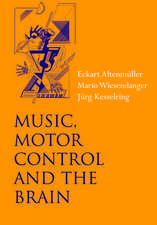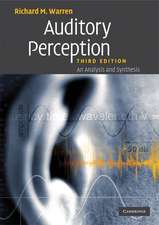Handbook of Basal Ganglia Structure and Function: Handbook of Behavioral Neuroscience, cartea 24
Editat de Heinz Steiner, Kuei Y. Tsengen Limba Engleză Hardback – 26 sep 2016
These nuclei are essential for normal brain function and behavior, and their importance is further emphasized by the numerous and diverse disorders associated with basal ganglia dysfunction, including Parkinson’s disease, Tourette’s syndrome, Huntington’s disease, obsessive-compulsive disorder, dystonia, and psychostimulant addiction.
This updated edition has been thoroughly revised to provide the most up-to-date account of this critical brain structure. Edited and authored by internationally acclaimed basal ganglia researchers, the new edition contains ten entirely new chapters that offer expanded coverage of anatomy and physiology, detailed accounts of recent advances in cellular/molecular mechanisms and cellular/physiological mechanisms, and critical, deeper insights into the behavioral and clinical aspects of basal ganglia function and dysfunction.
- Synthesizes widely dispersed information on the behavioral neurobiology of the basal ganglia, including advances in the understanding of anatomy, cellular/molecular and cellular/physiological mechanisms, and behavioral and clinical aspects of function and dysfunction
- Written by international authors who are preeminent researchers in the field
- Explores, in full, the clinically relevant impact of the basal ganglia on various psychiatric and neurological diseases
Preț: 832.52 lei
Preț vechi: 1131.41 lei
-26% Nou
Puncte Express: 1249
Preț estimativ în valută:
159.30€ • 166.77$ • 131.81£
159.30€ • 166.77$ • 131.81£
Carte tipărită la comandă
Livrare economică 29 martie-12 aprilie
Preluare comenzi: 021 569.72.76
Specificații
ISBN-13: 9780128022061
ISBN-10: 012802206X
Pagini: 1036
Dimensiuni: 216 x 276 x 85 mm
Greutate: 2.99 kg
Ediția:2. Auflage.
Editura: ELSEVIER SCIENCE
Seria Handbook of Behavioral Neuroscience
ISBN-10: 012802206X
Pagini: 1036
Dimensiuni: 216 x 276 x 85 mm
Greutate: 2.99 kg
Ediția:2. Auflage.
Editura: ELSEVIER SCIENCE
Seria Handbook of Behavioral Neuroscience
Public țintă
Neuroscience researchers in need of an overview of recent advances regarding the basal ganglia, neuroscience clinicians seeking information on the pathophysiology and associated diseases, and neuroscience graduate students looking for basic information on structure and functionCuprins
Part A: The Basal Ganglia System and its Evolution
1. History of the Basal Ganglia
2. Anatomical Organization of the Basal Ganglia
3. Evolution of the Vertebrate Basal Ganglia
4. Cell Types in the Basal Ganglia
Part B: Anatomy and Physiology of the Striatum
5. Striatal Medium Spiny Projection Neurons and their Connections
6. Cholinergic Interneurons of the Striatum
7. GABAergic Interneurons of the Striatum
8. Dopamine Signaling in Striatal Medium Spiny Neurons
9. Endocannabinoid Signaling in the Striatum
10. Nitric Oxide Signaling in the Striatum
11. Adenosine Signaling in the Basal Ganglia
Part C: Anatomy and Physiology of Globus Pallidus, Subthalamic Nucleus and Substantia Nigra
12. The Globus Pallidus
13. The Subthalamic Nucleus
14. The Substantia Nigra Pars Reticulata
15. Subtypes of Midbrain Dopamine Neurons
16. Neurophysiology of Substantia Nigra Dopamine Neurons
17. Plasticity in Dopamine Neurons
18. Regulation of Extracellular Dopamine: Release and Reuptake
Part D: Network Integration
19. Organization of Corticostriatal Projection Neuron Types
20. Organization of Prefrontal-Striatal Connections
21. Gating of Cortical Input to the Striatum
22. Corticostriatal Synaptic Plasticity in Physiological and Pathological Conditions
23. Organization of the Thalamostriatal Systems
24. The Rostromedial Tegmental Nucleus: Connections to the Basal Ganglia
25. The Rostromedial Tegmental Nucleus: A Modulator of Dopamine Systems
26. Integrative Networks Across Basal Ganglia Circuits
Part E: Molecular Signaling in the Basal Ganglia
27. Second-Messenger Cascades
28. DARPP32/Phosphatase Signaling
29. Transsynaptic Regulation of Basal Ganglia Gene Expression
30. Psychostimulant-Induced Gene Regulation in Corticostriatal Circuits
31. Epigenetics in Neuropathologies of the Basal Ganglia
Part F: Basal Ganglia Function and Dysfunction
32. Investigating Basal Ganglia Function with Cell-Type-Specific Manipulations
33. Basal Ganglia Re-Entrant Loops: Roles in Action Selection and Reinforcement
34. Memory Systems in the Basal Ganglia
35. Basal Ganglia Dynamics During Action Sequence (Motor) Learning
36. Abnormal Activities in Cortico-Basal Ganglia Circuits in Movement Disorders
37. Morphological Plasticity in the Striatum Associated with Dopamine Dysfunction
38. Neuroinflammation in Movement Disorders
39. Basal Ganglia Disorders Related to Striosome/Matrix Compartments
40. Drug Addiction: the Neural and Psychological Basis of a Compulsive Incentive Habit
41. Parkinson’s Disease: Cross-Talk Between Environmental Factors and Gene Defects
42. Parkinson’s Disease: Molecular Determinants of Vulnerability in Dopamine Neurons
43. Parkinson’s Disease: Genetics
44. Molecular Mechanisms of L-DOPA-Induced Dyskinesia
45. Cell Therapy in Parkinson’s Disease: An Update
46. Huntington’s Disease: Molecular Basis
47. Huntington’s Disease: Insights from Animal Models
48. Dystonia
49. Tourette Syndrome
50. Deep-Brain Stimulation for Neurologic and Psychiatric Disorders
1. History of the Basal Ganglia
2. Anatomical Organization of the Basal Ganglia
3. Evolution of the Vertebrate Basal Ganglia
4. Cell Types in the Basal Ganglia
Part B: Anatomy and Physiology of the Striatum
5. Striatal Medium Spiny Projection Neurons and their Connections
6. Cholinergic Interneurons of the Striatum
7. GABAergic Interneurons of the Striatum
8. Dopamine Signaling in Striatal Medium Spiny Neurons
9. Endocannabinoid Signaling in the Striatum
10. Nitric Oxide Signaling in the Striatum
11. Adenosine Signaling in the Basal Ganglia
Part C: Anatomy and Physiology of Globus Pallidus, Subthalamic Nucleus and Substantia Nigra
12. The Globus Pallidus
13. The Subthalamic Nucleus
14. The Substantia Nigra Pars Reticulata
15. Subtypes of Midbrain Dopamine Neurons
16. Neurophysiology of Substantia Nigra Dopamine Neurons
17. Plasticity in Dopamine Neurons
18. Regulation of Extracellular Dopamine: Release and Reuptake
Part D: Network Integration
19. Organization of Corticostriatal Projection Neuron Types
20. Organization of Prefrontal-Striatal Connections
21. Gating of Cortical Input to the Striatum
22. Corticostriatal Synaptic Plasticity in Physiological and Pathological Conditions
23. Organization of the Thalamostriatal Systems
24. The Rostromedial Tegmental Nucleus: Connections to the Basal Ganglia
25. The Rostromedial Tegmental Nucleus: A Modulator of Dopamine Systems
26. Integrative Networks Across Basal Ganglia Circuits
Part E: Molecular Signaling in the Basal Ganglia
27. Second-Messenger Cascades
28. DARPP32/Phosphatase Signaling
29. Transsynaptic Regulation of Basal Ganglia Gene Expression
30. Psychostimulant-Induced Gene Regulation in Corticostriatal Circuits
31. Epigenetics in Neuropathologies of the Basal Ganglia
Part F: Basal Ganglia Function and Dysfunction
32. Investigating Basal Ganglia Function with Cell-Type-Specific Manipulations
33. Basal Ganglia Re-Entrant Loops: Roles in Action Selection and Reinforcement
34. Memory Systems in the Basal Ganglia
35. Basal Ganglia Dynamics During Action Sequence (Motor) Learning
36. Abnormal Activities in Cortico-Basal Ganglia Circuits in Movement Disorders
37. Morphological Plasticity in the Striatum Associated with Dopamine Dysfunction
38. Neuroinflammation in Movement Disorders
39. Basal Ganglia Disorders Related to Striosome/Matrix Compartments
40. Drug Addiction: the Neural and Psychological Basis of a Compulsive Incentive Habit
41. Parkinson’s Disease: Cross-Talk Between Environmental Factors and Gene Defects
42. Parkinson’s Disease: Molecular Determinants of Vulnerability in Dopamine Neurons
43. Parkinson’s Disease: Genetics
44. Molecular Mechanisms of L-DOPA-Induced Dyskinesia
45. Cell Therapy in Parkinson’s Disease: An Update
46. Huntington’s Disease: Molecular Basis
47. Huntington’s Disease: Insights from Animal Models
48. Dystonia
49. Tourette Syndrome
50. Deep-Brain Stimulation for Neurologic and Psychiatric Disorders

























